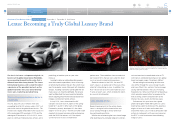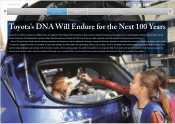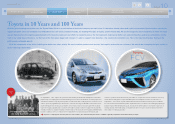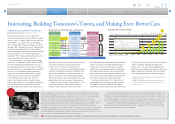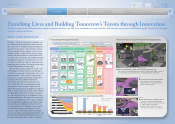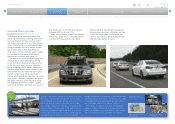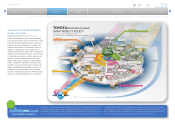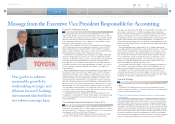Toyota 2014 Annual Report Download - page 15
Download and view the complete annual report
Please find page 15 of the 2014 Toyota annual report below. You can navigate through the pages in the report by either clicking on the pages listed below, or by using the keyword search tool below to find specific information within the annual report.
ANNUAL REPORT 2014
President’s MessagePresident’s Message
Overview of
Four Business Units
Overview of
Four Business Units
Special FeatureSpecial Feature
Review of OperationsReview of Operations
Consolidated Performance
Highlights
Consolidated Performance
Highlights
Management and
Corporate Information
Management and
Corporate Information
Investor InformationInvestor Information
Financial SectionFinancial Section
Page 15
NextPrev
ContentsSearchPrint
high-pressure hydrogen tank—critical compo-
nents of a fuel cell vehicle—that perform at world-
leading levels.
Toyota plans to start selling a fuel cell sedan in
Japan before March 2015. At first, the new vehi-
cle will be sold only in major cities that plan to
build hydrogen station networks. We are also
preparing to launch the sedan in the United
States and Europe around summer 2015. From
the 2020s onward, we expect the market for fuel
cell vehicles to increase significantly, with several
tens of thousands of vehicles sold per year.
Over the next 100 years, we believe electrified
powertrains will hold the key to the future of the
automobile. The first-generation Prius opened the
door to this future in 1997, and a new era of
transportation emerged once major challenges
were overcome. Similarly, fuel cell vehicles repre-
sent the next stage in the development of a future
“mobility society.” Toyota has embarked on a long
journey toward making hydrogen an everyday fuel
and fuel cell vehicles the norm.
The development of the first-generation Prius was a major turning point for Toyota. At the time, Chairman
Eiji Toyoda stated that Toyota must be in a position to help its customers and society more. The Prius was
conceived with this goal in mind.
What should cars look like in the 21st century? To answer this question, the G21 Project was launched in
September 1993 with 10 staff assembled from divisions across the Company, including engine, chassis,
and body engineering, as well as production technology. With “G” standing for Globe and “21” for 21st
century, the ambitious goal of the G21 Project was to double the fuel economy of existing engines.
The hybrid system was developed from scratch, and many obstacles were encountered along the way.
For example, the first prototype, completed in November 1995, simply stopped working after 49 days of
operation, and the engineers could not figure out why. That same year, the Prius concept car was displayed
at the Tokyo Motor Show to great fanfare. Encouraged by this reception, Toyota moved up the launch date
for the Prius to December 1997, from the original 1999, to coincide with the Kyoto Conference on Climate
Change (COP3).
The first-generation Prius was the result of a cross-organizational companywide effort to accelerate the
development of the hybrid system that included the integration of the development departments for system
control and electronic units. The Prius project was exceptional; in the extremely short time frame of two
years, completely new technologies were developed and put into mass production. The first-generation
Prius debuted with the slogan, “Just in time for the 21st century.” The core hybrid technologies developed
then can be applied to any type of eco car.
As long as innovation continues in hybrid technology, we can work toward a “mobility society” with more options for customers.
Staying ahead of the Times
Toyota’s
DNA
Fuel Cell System Development
Hydrogen tank
Power control unit
Battery
Fuel cell
stack
Motor
Boost converter
Nippon Charge Service Established to Promote the Development of Infrastructure for Electric-Powered Vehicles
Toyota Motor Corporation, Nissan Motor Co., Ltd., Honda Motor Co., Ltd., and Mitsubishi Motors Corporation jointly established a
new company, Nippon Charge Service, LLC (NCS), to promote the installation of chargers and development of a highly convenient
infrastructure network for electric-powered vehicles (PHVs, PHEVs, and EVs) in Japan. Through NCS, the companies will provide
financial support to help cover the cost of charger installation and maintenance to businesses and municipalities that install them,
helping to accelerate the advance of charging infrastructure. The speedy creation of this infrastructure will dramatically improve
customer convenience, helping society maximize the possibilities of electric vehicles.
Toyota in 10 Years and 100 Years [6 of 6] Our DNA is Creating Ever-Better Cars What Sets Toyota Apart Enriching Lives and Building Tomorrow’s Toyota through Innovation New Values for the Next Hundred Years Message from the Executive Vice President Responsible for Accounting


